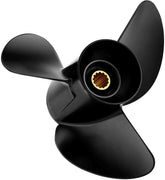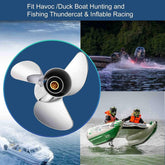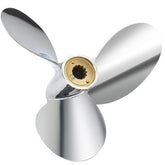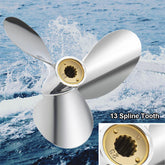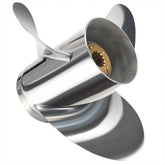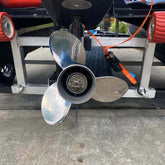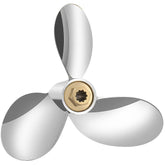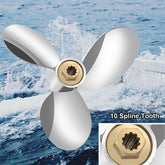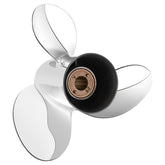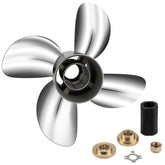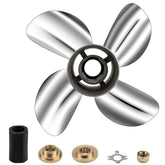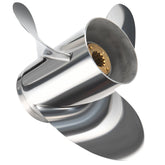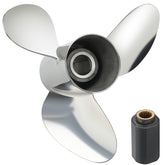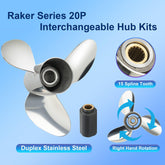How to Choose the Right Mercury Outboard Propeller: The Ultimate 2025 Guide
When it comes to upgrading your boat’s performance, choosing the right Mercury outboard propeller is one of the most important decisions you can make. Whether you're a seasoned boater or just getting started, selecting the right propeller is key to maximizing your boat’s speed, fuel efficiency, and handling.
While many boaters turn to trusted names like Mercury and Yamaha for their outboard propellers, high-quality alternatives exist that offer similar performance at a more affordable price. This guide will help you understand how to choose the right propeller based on your specific needs, ensuring your boat performs at its best.
1. Understanding Mercury Outboard Propellers
What is a Mercury Outboard Propeller?
A Mercury outboard propeller is a critical component that transforms the power from your engine into forward motion. By rotating through the water, it generates thrust that pushes your boat forward. Without the proper propeller, your engine won’t perform at its best, leading to inefficiency and possibly even engine damage.
Mercury offers a wide range of propellers designed to suit various types of outboard motors, with different pitches, diameters, and blade counts to match the needs of recreational boaters, fishermen, and water sports enthusiasts.
Why is the Right Propeller Important?
Choosing the right propeller isn’t just about getting your boat moving—it affects everything from fuel efficiency to how your boat handles at different speeds. For instance, selecting a higher pitch propeller can increase your boat's top speed, while a lower pitch gives better acceleration. The correct propeller will allow you to reach your cruising speed quicker, conserve fuel, and handle rough waters with ease.
2. Material Options for Mercury Outboard Propellers

Mercury outboard propellers are typically made of aluminum or stainless steel. Both materials have unique benefits depending on the type of boating you do and your performance needs.
Aluminum Propellers: Lightweight and Affordable
Aluminum propellers are lightweight and more affordable, making them a great choice for recreational boaters or anyone on a budget. They offer decent performance for lighter boats or smaller engines.
-
Pros:
-
More affordable than stainless steel
-
Lightweight and easier to replace
-
Ideal for small to medium boats (under 75hp)
-
-
Example: A Mercury 9.9hp engine might pair well with an aluminum propeller like the 48-812949A02 (7.8" diameter, 6-pitch, RH rotation), offering excellent acceleration and fuel efficiency.
Stainless Steel Propellers: Durability and Performance
Stainless steel propellers are more durable and are built to handle higher horsepower engines. They’re better for larger boats or those needing more thrust and speed.
-
Pros:
-
More durable and resistant to damage
-
Better fuel efficiency at higher speeds
-
Ideal for heavy-duty applications and high-horsepower engines
-
-
Example: For a Mercury 115hp engine, a stainless steel propeller like the 48-828152A12 (9 1/4" diameter, 7-pitch, RH rotation) would offer superior performance and better speed on the water.
3. 3-Blade vs. 4-Blade Propellers: Which One is Right for You?

Choosing between a 3-blade propeller and a 4-blade propeller depends on the type of performance you want from your boat.
3-Blade Propellers: Speed and Efficiency
The 3-blade propeller is the most common choice among boaters. It provides a good balance of speed and fuel efficiency, making it ideal for boats with lower horsepower engines or those used for cruising.
-
Pros:
-
Faster top-end speeds
-
Better fuel efficiency at cruising speeds
-
Great for lighter boats and performance setups
-
-
Example: A Mercury 25hp engine with a 3-blade propeller like the 48-897748A11 (9 1/4" diameter, 8-pitch, RH rotation) would perform well for general recreational use.
4-Blade Propellers: More Thrust and Better Control
The 4-blade propeller offers better control, particularly at lower speeds or when towing heavy loads. If you often operate in rough waters, need more thrust, or tow a lot, a 4-blade propeller will give you better handling.
-
Pros:
-
Smoother low-speed performance
-
Improved thrust for heavier boats or towing
-
Reduces cavitation and improves grip
-
-
Example: A Mercury 70hp engine might pair well with a 4-blade propeller like the 48-8M8026620 (10.6" diameter, 11-pitch, RH rotation), giving you better low-speed control and more stability in choppy waters.
4. Understanding Propeller Pitch and Diameter
When selecting the right propeller, two key factors to consider are pitch and diameter. Let’s break them down using an example of a 13x19 propeller, a common choice among boaters.
What is Propeller Pitch?

The pitch refers to how far the propeller would theoretically move forward in one full rotation. A higher pitch allows your boat to travel farther with each revolution, which is great for top-end speed. However, it requires more power from the engine to maintain speed, which might reduce acceleration.
-
Higher Pitch (19): Works like a higher gear in a car. The boat moves farther per revolution, giving you better top speed but slower acceleration.
-
Lower Pitch: Works like a lower gear in a car. It gives you faster acceleration but sacrifices some top-end speed.
A 13x19 propeller is ideal for boaters who want to strike a balance between speed and acceleration, especially in moderate to high-speed cruising conditions.
Choosing the Right Diameter
The diameter of a propeller refers to its overall width. A larger diameter propeller moves more water per revolution, generating more thrust. This is great for heavier boats, especially in low-speed or towing situations. However, a propeller that is too large will create drag and reduce RPM, leading to inefficiency.
-
13-inch Diameter: A 13-inch diameter propeller, such as the 13x19, strikes a balance by providing ample thrust without over-dragging the engine. It’s perfect for moderate-to-heavy load situations while maintaining a reasonable RPM for top speed.
5. Choosing the Right Propeller for Your Engine
When selecting a propeller, it’s crucial to match it with the horsepower and engine specifications. For example, a Mercury 40hp engine might benefit from a 3-blade propeller like the 48-828152A12 (9 1/4" diameter, 7-pitch, RH rotation) for optimal balance between speed and thrust.
Engine Year and Compatibility
Make sure your chosen propeller is compatible with your engine's year and model. Mercury has made several advancements in engine technology, and choosing the wrong propeller could affect performance.
6. How to Maintain Your Mercury Outboard Propeller
Proper maintenance will extend the life of your propeller and keep your engine running efficiently.
Regular Inspection and Cleaning
Clean your propeller after each use to remove saltwater, dirt, and debris. Regular inspections will help detect cracks, corrosion, or dings before they become a serious issue.
Lubrication and Greasing
Ensure the propeller hub and shaft are regularly greased to prevent rust and wear. Mercury recommends using a marine-grade grease to keep everything running smoothly.
Balancing Your Propeller
If your propeller isn’t balanced, it can cause vibrations that affect engine performance. Make sure to get it balanced regularly to keep your boat running smoothly.
7. How to Replace Your Mercury Outboard Propeller
Replacing a propeller is simple but requires careful attention.
-
Gather the Necessary Tools: You’ll need a propeller wrench and grease.
-
Remove the Old Propeller: Use the wrench to loosen the propeller nut and carefully remove the propeller.
-
Install the New Propeller: Align the new propeller and tighten the nut securely.
-
Test the Boat: Run your boat at low speeds to ensure everything is working smoothly.
8. Frequently Asked Questions (FAQs)
What is the best propeller for my Mercury outboard motor?
The best propeller for your engine depends on your horsepower and the type of boating you do. For a Mercury 115hp engine, a 12” to 14” pitch propeller, like 48-816702A40, would be a great choice for both top speed and fuel efficiency.
How often should I replace my Mercury propeller?
You should replace your propeller if you notice any visible damage or decreased performance, such as cracks, corrosion, or a loss of speed.
Can I use a 4-blade propeller instead of a 3-blade?
Yes! A 4-blade propeller provides better thrust and handling at low speeds, making it a great option for those who often boat in rough waters or carry heavy loads. It might reduce top speed slightly compared to a 3-blade, but the added control can be well worth it.
Why Choose an Affordable Alternative to Mercury or Yamaha?
While Mercury and Yamaha offer excellent quality, there are affordable alternatives available that provide similar performance and durability. VIF Propeller, for example, offers reliable aftermarket options that meet or exceed OEM standards, allowing you to enjoy high-performance results without the premium price tag. Whether you're looking for aluminum or stainless steel propellers, VIF ensures durability and efficiency, giving you the best of both worlds—top-tier performance and cost-effective pricing.
By understanding the different factors that affect propeller performance, you can make an informed decision that will improve your boat’s performance and overall experience on the water. With affordable, high-quality options available, you don’t have to overpay for OEM parts to enjoy top-tier performance.
Happy boating!


